Snapdragon (Antirrhinum majus) for the Farmer Florist
The snapdragon (Antirrhinum majus) is a member of the Scrophulariaceae family. Antirrhinum is Greek for “like” and “nose” in reference to the flower’s shape. The flowers are 1¼–1½ inches long. They are tubular with rounded upper and lower lips and can be single (Figure 1), double (Figure 2), or open-faced (“butterfly”) (Figure 3) without a lip.
Up to 15 flowers appear close together along the stem, which measures up to 3 feet in length when cut. The diverse flower colors of the snapdragon’s tall spikes allow florists and consumers numerous design options. Most of the snapdragon stems in flower shops are grown in greenhouses under carefully controlled conditions to provide long, straight stems. However, many consumers and florists prefer the more casual look of field-grown stems. They are easy to row and come in a wide variety of colors.

Image courtesy Johnny’s Selected Seeds.

Image courtesy Johnny’s Selected Seeds.
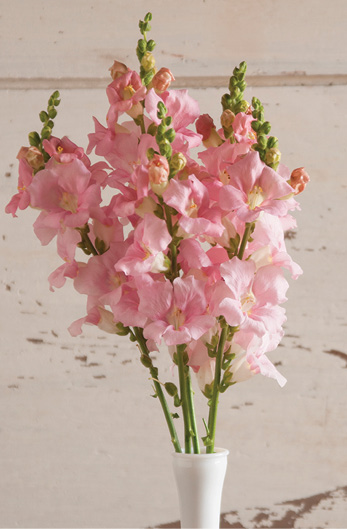
Image courtesy Johnny’s Selected Seeds.
Production
Snapdragons are organized into four different groups (I–IV) based upon cultivars’ vegetative and reproductive responses to seasonal temperatures and photoperiod. Group I cultivars are considered the winter-flowering snapdragons, performing with short days and low light; Group II flower in late winter to early spring, with increasing day length and temperatures; Group III consist of spring-flowering varieties; and Group IV flower under high light intensities, long days, and night temperatures above 60ºF (16ºC). Flower growers must consider seasonal timing and choose cultivars from appropriate groups.
Snapdragons are annuals, and they perform well in sun to part shade in cooler parts of the year. Seeds germinate in 7–14 days at 70–75ºF. Light is required for germination, but a fine layer of vermiculite covering the seeds can maintain moisture levels and prevent algae growth. Bottom-water or mist lightly to avoid covering the seed with displaced soil. Transplant to packs or larger containers when the first true leaves appear, approximately 3–4 weeks after sowing. If desired, pinch back to 1½–2 inches when the seedlings are about 3–4 inches tall to encourage branching. Direct seeding is not recommended. Sow 8–10 weeks before the last frost in your area if growing outside. Snapdragons perform well in full sun to partial shade. Plants should be spaced 4–12 inches apart.
Weeds compete for water, nutrients, and light, which results in reduced flower yield and increased threat of serious insect and disease problems. A successful weed-management program uses cultural practices, such as cultivation and mulching, or a combination of cultural and chemical measures, taking into consideration labor costs and the cost and availability of materials. Potentially useful herbicides include Dacthal, Fusilade, Treflan, metoclachor, Poast, and Acclaim.
High humidity, overhead watering, and plant debris may lead to increases in disease incidence. Common disease problems in snapdragons include anthracnose, botrytis blight, rust, powdery mildew, downy mildew, and root rots. Correct diagnosis of the disease is important for making management decisions.
Symptoms of anthracnose include yellow spots on leaves and stems; these spots turn white with brown borders. Leaves may die, and anthracnose may lead to the plant’s death if stems are girdled by lesions.
Petals affected by botrytis blight will turn brown and be covered with gray fungal growth.
Downy mildew leads to stunted plants with leaves that curl downward. The undersides of leaves will be covered by a gray to white fungus, and yellow areas will appear on the upper sides of the leaves. Plants affected by downy mildew may fail to flower.
Powdery mildew is easily identified by a white fungal growth that appears on either surface of lower leaves, as well as on the stems of some cultivars.
Wilting is usually the first sign of root rots. Plants affected by Pythium root rot have roots that are dark brown. The cortex of the root (outer tissue) can be easily separated, leaving behind the thread-like stele. Plants with Rhizoctonia root rot have reddish-brown lesions at the base of the stem. Rust disease leads to small, yellow swellings on the leaves or stems. These open to release rust-colored spores.
Sanitation is the most important factor in managing plant disease. Remove fallen plant material from the growing area to interrupt the life cycle of disease-causing organisms and reduce overall disease problems. Watering by drip irrigation will reduce disease problems by limiting free water on the leaves and stems of the plants. Fungicides can be effective for managing foliar diseases of snapdragons. Chlorothalonil, thiophanate-methyl, mancozeb, and copper formulations are common fungicides used for disease management in snapdragons.
Insect pests of snapdragons include aphids, whiteflies, leafminers, and a number of foliage-feeding caterpillars. Mites may also be a problem for snapdragons. It is important to regularly monitor plants to detect insect infestations early when they have done less damage and are easier to control.
Aphids, whiteflies, and mites can be controlled with applications of neem oil or insecticidal soap. Repeated applications may be necessary.
Leafminers feed on the interior of leaves, resulting in winding galleries. Spinosad insecticides are effective against leafminers.
Caterpillars feed on foliage and may be controlled by a range of insecticides. Bacillus thuringiensis (Bt) insecticides can control young, small caterpillars; however, Bt insecticides do not offer effective control of larger caterpillars.
When employing chemical pesticides, it is the user’s responsibility to understand and follow all label instructions. Pay special attention to allowable use, application rates, personal protective equipment required, and re-entry intervals. Review product labels before purchasing a product.
Contact your county MSU Extension office for information on herbicides, fungicides, and insecticides for use in flower production. Chemical registrations and approved uses change periodically. You can find labels and further information on chemical management tools at www.kellysolutions.com/MS/, www.cdms.net/, and www.greenbook.net.
Harvest and Handling
When grown for one cut, stems can be as long as the full height of the plants (12–60 inches). When grown for multiple cuts per plant, stems vary in length from 12–36 inches. A fresh snapdragon has a few blossoms open at the base of the flower spike, with the others in bud stage and showing good size and color. Cutting off the tightly budded tips encourages the other blooms to open sooner. Harvest the stems when florets on the lower third to half of the spike are open.
Most snapdragon cultivars are sensitive to ethylene, a natural plant growth hormone that accelerates maturation of flowers and shortens vase life. Older flowers on a stem are more susceptible to ethylene than younger ones. However, some cultivars are naturally ethylene-resistant, so treatment with 1-methylcyclopropene (1-MCP) or silver thiosulfate (STS) is not very effective. For cultivars that are sensitive to ethylene exposure, treatment with 1-MCP or STS protects snapdragon flowers from ethylene-induced shattering or flower drop.
Snapdragons also benefit from an overnight treatment at 70–100ºF with a fresh flower food fortified with 7 percent sucrose. Snapdragons are best stored with only a few flowers open. However, this often results in poorly developed flowers on the spike and fading color at the tip. Spikes cut with only one or two flowers open should be opened in a solution containing 30 ppm 8-hydroxyquinoline citrate (8-HQC) and 1.5 percent sucrose. This also can be used as a vase solution.
Snapdragon stems quickly twist their tips upward when lying on their sides for even a short period of time, even after cutting. Even leaning the stems against the side of a half-empty bucket will result in a significant bend. Store the stems straight at all times. Snapdragon stems can be stored at 33–35ºF for 7–10 days if wrapped in polyethylene film to slow moisture loss.
Cultivar Recommendations
There are two main groups of snapdragons: garden varieties and greenhouse varieties. Avoid greenhouse types for outdoor production because they are bred to grow in specific greenhouse seasons and are not generally adapted to outdoor production.
Suggested Cultivars
- Madame Butterfly Series
- Double-petal type
- Bronze with White, Yellow, Bronze, Ivory, Pink, Red, Rose
- Chantilly Series
- Early, open-faced flowers
- Light Pink, Cream Yellow, Velvet, White, Bronze, Purple
- Group I–II
- Rocket Series
- Strong stems and good branching
- White, Orchid, Red, Golden
- Group III–IV
- Potomac Series
- Field or greenhouse production
- Red, Cherry Rose, Orange, Royal, Yellow, Appleblossom, Lavender, White, Pink
- Group III–IV
Design Applications
Arrangement
Line materials such as snapdragons can stand alone to create impactful arrangements. The following design examples use ‘Chantilly Bronze’ snapdragons (Group I–II), featuring open-faced florets and a bright, coral color.
This traditional line-mass example of an equilateral triangular pattern is “three-sided.” The arrangement is decorative on three sides, and the back is plain with few, if any, flowers. Such designs are best displayed against walls or on altars, consoles, pulpits, or podiums, but they are not suitable for buffet events where service occurs on all sides of the table.
This design is made by establishing the height, width, and depth of the arrangement with the first four snapdragon stems. When creating a pair of these designs, it is best to make each design in stages, beginning with the mechanics. Once the mechanics are prepared, match the height, width, and depth of both designs with the first four placements, then add several additional stems to each design in order to make them similar in fullness.
The container in Figure 4 was made with branch segments nailed to a wooden box lined with a double layer of poly foil. Hydrate fresh floral foam using the free-float method, then place it in the liner. Bevel the foam so that the paper-covered wire, which holds the foam in the container, remains stable with less cutting into the block.
Double the paper-covered wire segments, and wind them completely around the container; then, twist the ends together and trim. The wire fits between the branch segments (Figure 5) and blends with the natural bark container (Figure 4). At this stage, remember to add some floral food solution to the reservoir of the container—not so much that it is difficult to transfer the design, but enough to sustain the arrangement until more solution can be added.
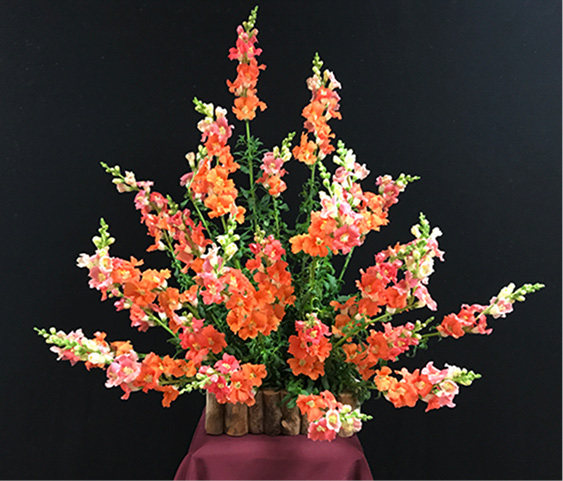

Centerpiece
When planning decorations for guest tables at an event, you may not know table sizes and shapes until you get there. A good technique in such situations is to create several small designs (see Figure 6). When it is time to decorate the tables, small designs can be configured in triangles or squares to decorate round tables. Place them in straight lines or zigzags to adorn rectangular or oval tables. The snapdragons in Figure 6 were arranged using two to three stems per vase, with each stem falling on a diagonal. The geometry of the overall design is not so much about arranging the vases, but keeping an eye on the spikes’ terminals to achieve a triangular form of flowers.
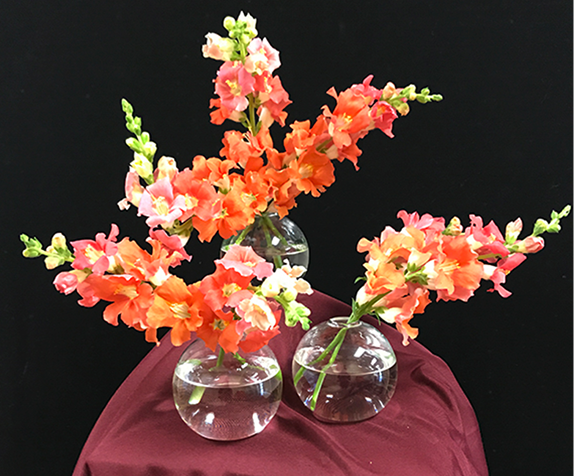
Flowers to Carry
The informal, hand-tied bouquet in Figure 7 uses paper-covered wire to bind approximately 15 snapdragon stems. The stem placement follows the traditional spiral placement technique, while the overall bouquet is asymmetric. A double-faced, coral, satin bow completes this quick design.
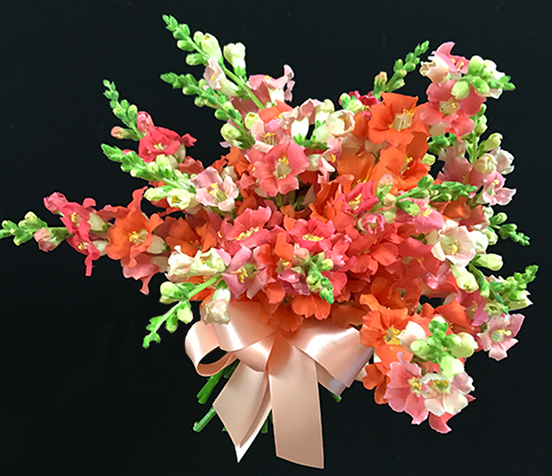
Corsage/Boutonniere
Snapdragons can hold up for several hours if treated with multiple coats of anti-transpirant spray. For a boutonniere, construct the armature from 12-gauge decorative aluminum. Jewelry pliers help to bend the malleable wire into curls and are a necessary tool for these designs. For the wrist corsage, tie a bow to the frame and adhere snapdragon florets using florist’s cold glue.
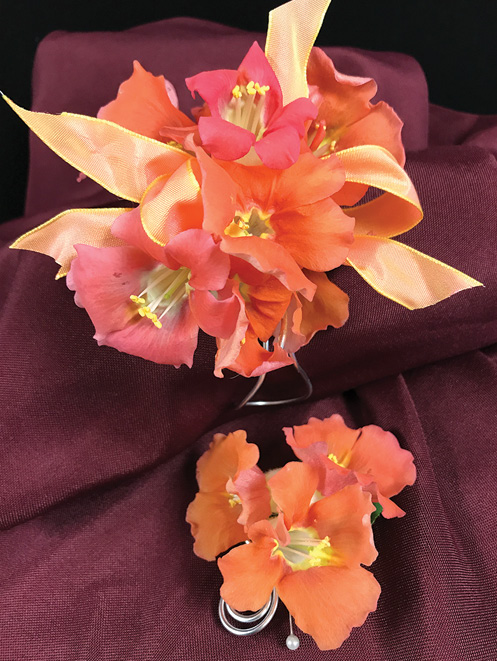
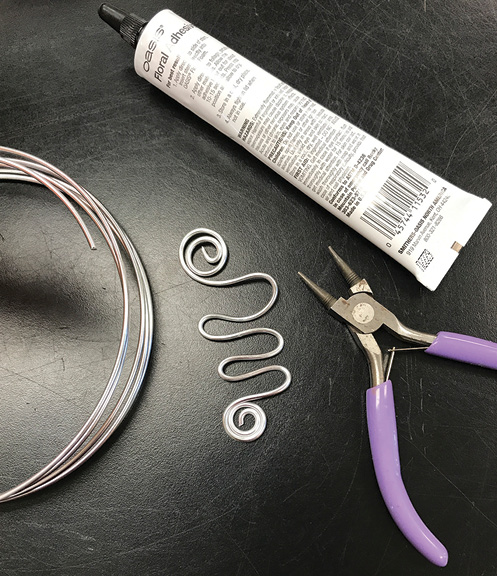
References
Armitage, A. M., & Laushman, J. M. (2003). Specialty cut flowers: The production of annuals, perennials, bulbs, and woody plants for fresh and dried cut flowers. Portland, OR: Timber Press.
Arnosky, F., & Arnosky, P. (1999). We’re gonna be rich! Growing specialty cut flowers for market. Lawrence, KS: Fairplains Publications, Inc.
Byczynski, L. (1997). The flower farmer: An organic grower’s guide to raising and selling cut flowers. White River Junction, VT: Chelsea Green Publishing Co.
Dole, J. & Wilkins, H. (2005). Floriculture: Principles and species. Upper Saddle River, NJ: Pearson.
Heffernan, C. (2002). Flowers A to Z: A practical guide to buying, growing, cutting, arranging. New York, NY: Harry N. Abrams, Inc.
Johnny’s Seeds. (2018). Snapdragons.
Nell, T. A., & Reid, M. S. (2000). Flower and plant care. Society of American Florists. NC Commercial Flower Growers’ Assoc.
Stevens, A. B. (1998). Field grown cut flowers: A practical guide and sourcebook, commercial field grown, fresh, and dried cut flower production. Edgerton, WI: Avatar’s World.
University of Massachusetts Center for Agriculture, Food, and the Environment. (2002). Weed management for outdoor cut flowers.
Whipker, B. E., & Dole, J. M. (Eds.). (2003). Southeast Outdoor Cut Flower Manual, 2nd ed.
Special thanks to David Mills, The Nature of Things, Courtland, Mississippi, for the wooden container, and to Patrick Broussard, Susan Deblanc, Christian Stephenson, PhD, and Corey Wheeler, MSU Coastal Research and Extension Center, for their assistance.
The information given here is for educational purposes only. References to commercial products, trade names, or suppliers are made with the understanding that no endorsement is implied and that no discrimination against other products or suppliers is intended.
Publication 3301 (POD-01-25)
By Christine Coker, PhD, Extension/Research Professor, Coastal Research and Extension Center; James DelPrince, PhD, Associate Extension Professor, Coastal Research and Extension Center; and Christian Stephenson, PhD, former Extension Agent, Hancock County.
The Mississippi State University Extension Service is working to ensure all web content is accessible to all users. If you need assistance accessing any of our content, please email the webteam or call 662-325-2262.



